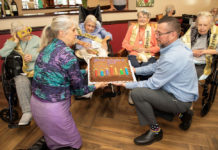Low-income, working poor and elderly run short of food
each month, despite help from food bank programs
by Barry W. Dugan – Managing Editor
A new study by the county’s largest emergency food provider
paints a painful picture of hunger in Sonoma County where the high
cost of living causes low-income families, working poor and elderly
residents to run short of food each month.
Despite the many emergency food programs and public assistance
available, the survey by the Redwood Empire Food Bank (REFB) found
that the “unique economics of Sonoma County directly contribute to
hunger in vulnerable populations,” particularly households with
children, senior citizens and the disabled.
Even with the REFB distributing food to 38,000 people per month
at a variety of sites, and local food banks supplementing that
distribution, it’s not enough.
“The community is just not getting the job done,” said David
Goodman, director of the REFB. “Studies conducted in 1986 and 1999
told us there are hungry people in Sonoma County, but these new
findings are even more disturbing. Hunger remains a chronic and
painful reality for many people in Sonoma County, especially
children and seniors.”
North County food pantry advocates said the economy is making
the situation even worse. “Our numbers have gone up incredibly in
the last three months,” said Susan Graf, co-chair of the Healdsburg
Shared Ministries Food Pantry.
Graf confirmed the survey’s findings that many of the county’s
hungry are working families. “These are not people standing with
their hands out in the unemployment line,” she said. “They are
working families just don’t have enough to make it to the end of
the month … that is why the Healdsburg food pantry was founded to
help people get to the end of the month.”
Ida Spiller, coordinator of the Windsor Service Alliance’s food
pantry, said the pantry’s numbers have also been increasing. “We’re
getting more and more people every week,” she said. “There’s a lot
of families where both parents are working and they still can’t
make it.”
The survey, “Understanding the Economics of Hunger in Sonoma
County,” was conducted over the past nine months at a variety of
food distribution sites in the county, including Windsor,
Healdsburg, Sebastopol and Occidental. More than 300 people were
interviewed. (The survey can be found at www.refb.org)
The survey was conducted with the help of Sonoma State
University’s Center for Regional Economic Analysis, Brandeis
University’s Center on Hunger and Poverty, and Mathematica Policy
Research, Inc.
Goodman said the survey was “an educational tool. Before we ask
people to get involved, they need to understand the issue. We want
to see a compassionate community, an understanding community. We
want to dispel myths. The face of hunger in Sonoma County is just
like you and me.”
The key findings include:
- The high cost of living in Sonoma contributes directly to
hunger. Of the recipients who pay for housing, 51 percent of their
income goes to rent or mortgage.
- As many as 81 percent of people receiving food distributions
often or sometimes don’t have enough money to purchase food for an
entire month.
- Households with children are particularly vulnerable to hunger;
75 percent of recipient households with children have incomes below
the federal poverty line ($18,000 for a family of four). Households
with children have the greatest experience of hunger — 93 percent
sometimes or often run out of food and do not have enough money to
buy more. When asked if their children were ever hungry and did not
eat because they couldn’t afford enough food, 24 percent answered
“yes.”
In Sonoma County, where the cost of living is so high, the
poverty line is much higher than $18,000 federal level, said
Goodman.
“Living in Biloxi is much different than living in Sonoma
County,” he said. “Somewhere relative to that poverty line number,
people need help. How far down do people have to go before we are
wiling to give them a helping hand?”
The California Budget Project estimates that in Sonoma County, a
family of four with two working parents needs an income of $61,000
to raise a family. “Even if that number is exaggerated, there is
still an enormous disparity between the poverty line and what it
takes to make ends meet in Sonoma County … What is the right
number? No one is going to say $18,000.”
- Senior citizens living on Social Security experience hunger at
an alarming rate: 55 percent of recipient households with at least
one senior have incomes below the federal poverty line; 53 percent
report that they sometimes or often run out of food; and 16 percent
of seniors interviewed experience hunger — the physical pain of
not having enough to eat.
- Many people who need food assistance are not fully utilizing
assistance programs, and when they do, the programs are not meeting
their needs. Food stamp recipients report that the monthly
allowance lasts two weeks; only 41 percent of households with
preschoolers participate in the Women, Infants and Children (WIC)
program; just 60 percent of recipient households participate in a
school lunch program; and only five percent participate in a summer
lunch program.
Goodman said prejudice, misconceptions and bureaucratic
regulations are the biggest barriers to solving the hunger problem.
“Being on disability should not equate to hunger. Being injured, or
being an illegal immigrant or being unemployed … those should not
determine whether you are hungry. What’s the next alternative? I
can no longer see the alternative. Let’s just feed the people. The
food is available. That food, in combination with smart government
programs, can solve the problem.”
The hunger survey will hopefully spur the community into action,
said Goodman.
“Once people are educated and compassion, the point is really to
do something … do anything,” he said, “which is probably more than
many of them are doing now.”
He suggests volunteering at your local food pantry, donating
money to a food program or starting a food pantry. “It’s almost
endless what people can do,” said Goodman. “Tell a friend. Dispel a
myth. Changing a mind is one of the most powerful things you can
do.”
While Sonoma County has many philanthropic and charitable
organizations, the REFB still needs more support. “We have a donor
base of 9,000 people and there are 450,000 people in the county,”
Goodman said. “I don’t think everybody is on board. Hunger is
invisible in America. It’s a very quiet type of pain.”
The survey includes a series of recommendations:
- Improve the food stamp program. One way is to eliminate the
state’s car rule, which disqualifies applicants if their car is
worth more than $4,650. “Look at this silly barrier,” said Goodman.
“In Sonoma County, where we don’t have good public transportation,
we want people to work, yet we insist that they own a jalopy to get
to work.”
- Increase and expand school nutrition programs, such as
increasing the number of sites for summer lunch programs,
increasing the financial reimbursements to schools and lessen the
administrative burdens, and take advantage of programs that
automatically qualify children for free or reduced meals if their
families are already receiving assistance.
- Strengthen government programs, including expanding senior
nutrition programs and ensuring that people with disabilities have
enough food to meet their nutritional needs.
- Build community partnerships to end hunger. The study
recommends “The county government should increase its financial
support of hunger relief organizations.”
It also recommends increasing community outreach, establishing
more food distribution sites at senior dining sites and senior
housing sites, and expand programs to serve all low-income people.
“As a community we need to make a commitment that no one should go
hungry,” the report states.
Goodman is confident that “if we did every one of the
recommendations in this study, a lot more people would be living
without the threat of hunger, or hunger itself. We would be
investing in our children and in our future. We would have a
community that was engaged and involved and compassionate about
helping their less fortunate neighbors. And they are indeed our
neighbors. We are standing next to them every day.”








